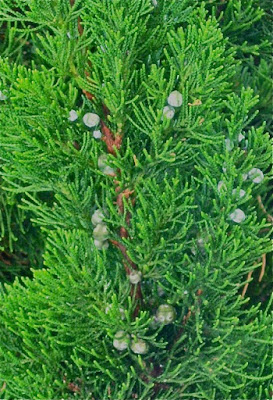 |
| Berries on a Hollywood juniper, Juniperous chinensis 'Torulosa' |
"The Corporal went away and I sat by myself, eating scorched potatoes and stringy beef. I'd found a late patch of charlock near the stream, leaves wilting and brown around the edges, and had brought back a handful in my pocket, along with a few juniper berries picked during a stop earlier in the day. The mustard leaves were old and very bitter, but I managed to get them down by wodging them between bites of potato. I finished the meal with the juniper berries, biting each one briefly to avoid choking and then swallowing the tough, flattened berry, seed and all. The oily burst of flavor sent fumes up the back of my throat that made my eyes water, but they did cleanse my tongue of the taste of grease and scorch, and would, with the charlock leaves, maybe be sufficient to ward off scurvy."
-- DRAGONFLY IN AMBER, by Diana Gabaldon, Chapter 33, "In Which Quite A Lot of Things Gang Agley"This is the most unappetizing passage I can think of from the OUTLANDER books. Having cleared more than my share of overgrown junipers from neglected landscapes and suffered prickly skin rashes from contact with their leaves, I cannot imagine thinking that eating the berries would be a good idea. However, people have and apparently do - see the Medicinal Uses section below.
As far as I am concerned, the Murray clan has found a better use for the plant. They use juniper (in Gaelic, it is called Aitionn) as their clan badge. Men attach sprigs of it to their caps; women fasten bits of the foliage to their sashes at the shoulder.
As you may know, the berries are used to flavor gin, a practice that is believed to have originated in Holland. The name of the drink is short for the Dutch word for juniper - "genever." However, I've discovered some bad news for fans of gin and tonic in Scotland and England. A fungal disease, phytopthora austrocedreae, has infected nearly 80% of existing junipers in the UK, causing people there to wonder if they may be facing a gin shortage.
Botanical Information
Family: CupressaceaeGenus: Juniperus
Species: There are many! By some counts over 60 different species grow in the Northern Hemisphere. Here is a list.
Common Name: Juniper is the name used generally, but individual species have their own names. For examples, Juniperous chinensis is called Chinese juniper; Juniperous conferta, Shore juniper; Juniperous virginiana, Eastern juniper or Eastern Redcedar (this is the so-called cedar used in drawers to repel moths).
Medicinal Uses
According to Ellen Evert Hopman, writing in A Druid's Herbal, juniper is "primarily a diuretic, the berries help digestive problems, gastrointestinal inflammations, and rheumatism."During the Thirty Years War, gin, called "Dutch Courage" - was given to English soldiers before battle to calm them.
The popular drink, gin and tonic, had its origins as a sort of medicine in tropical British colonies. Tonic water in those days contained quinine, the only effective anti-malarial compound available at the time. Gin was added to the tonic water to mask the bitter taste of the quinine.
Well that was fascinating, thanks rereading DIA presently. Use to love Gin but now can't stand the smell or the taste, weird I know. Sláinte Mhaith!
ReplyDeleteI had a bad experience with cherry sloe gin long, long ago. The smell of gin still makes me queasy all these years later, so I know just what you mean. :(
Delete